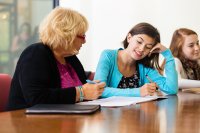The Work of Welcoming
Simple strategies to build community and make students feel welcome and safe in the classroom.
Your content has been saved!
Go to My Saved Content.In her beautiful book Radical Presence: Teaching as a Contemplative Practice, Mary Rose O’Reilley writes, “Hospitality defines a space for a visitor—the student—to be herself, because she is received graciously.... Hospitality calls me to consider the singularity of each person… to try [to receive each student] with unconditional presence.” O’Reilley describes a way of teaching that is both practical and personal, grounded in preparedness and presence.
I’ve taught in both traditional and nontraditional settings for nine years. However, only recently have I begun to understand hospitality as part of that work. When I started to reframe teaching as the work of welcoming, of stewarding a space, of receiving my students with unconditional presence, my classroom and my students’ learning changed.
Incorporating the Practice of Hospitality in the Classroom
There’s a sign on my classroom door that reads: “We value your class, color, gender, and orientation. This is a safe space.” The sign indicates that I care about the story each student brings to the classroom; however, the building of class culture is what carries through on that promise of safety. My effort to cultivate an inclusive classroom culture has three components.
1. Assign seats—and switch them around: Like a host at a formal gathering, I make a place for each student. I assign seats daily. I consider the social dynamic of the classroom and prepare a space for my students to work with different people and to hear different stories.
2. Work with students to build a class conversation contract: Early in the semester, my students do an exercise called the Perfect Conversation. Students rank a number of values-based statements from “strongly agree” to “strongly disagree.” They then pair up, with each pair finding their point of greatest difference and sharing the stories that led them to their answers. While one partner talks, the other listens. When the listening partner is able to accurately summarize the talking partner’s points, the listening partner takes their turn to share.
After the exercise, partner groups discuss the experience of listening and being listened to and discuss how we can work as a class community to set guidelines that encourage productive and empathetic discussion. This activity sets the groundwork for my class to create a class conversation contract.
3. Develop rhythms and routines that support the sharing of stories: Prior to working with high school students, I taught elementary and middle school students in schools where each day began with morning meeting. In my current classroom, I’ve adapted this practice to the needs of high school sophomores and juniors.
We begin each class period with a question, usually related to the content of class that day. When students feel ready to answer aloud, they gather in a circle at the front of our classroom. I have a ball, and I toss it to the first person who’s ready to share; after that person has shared, they toss the ball to someone else. This routine of sharing ideas and stories, as well as gathering in a circle and sharing a physical connection with each other—through the tossing and catching of the ball—creates community, fostering a welcoming and supportive classroom culture.
Building Inclusive Curriculum
In The Courage to Teach, Parker Palmer writes, “Hospitality in the classroom requires that we not only treat our students with civility and compassion but that we also invite our students and their insights into the conversation. The good host is not merely polite to the guest, the good host assumes the guest has stories to tell.”
Part of hospitality is honoring what students bring to the classroom, while also inviting them into a new experience. This aspect of hospitality also has three parts.
1. Rethink participation: Limiting contributions in class discussions to those students confident enough to raise their hands would limit my capacity to welcome everyone’s voice into the conversation. During a given class period, we might do a chalk talk, journal, draw, hold a Harkness discussion, or engage in serial testimony, all in an effort to let every voice be heard.
2. Provide both mirrors and windows: The readings, art, and videos used in class should include both mirrors and windows for students: Mirrors allow them to see themselves in the class content, and windows give them the opportunity to understand the perspective of another. I incorporate a diversity of races, genders, sexual orientations, ages, and physical abilities in the authors, artists, and speakers whose work I assign.
3. Share space in class conversations: I work not to prioritize my voice over the voices of my students through established rhythms and routines—for example, I ring a chime rather than raise my voice above my students’ voices when I need to interrupt conversations and bring us back together as a group. I also work on this through the way I structure lessons.
Because I’m the teacher, my voice is often privileged over the voices of students. By sharing space in the conversation, stepping back from my own place of power into a space of humility and hospitality, I not only demonstrate generosity and justice but also learn from my students and hear their stories, empowering them to do the same for each other both inside and outside the classroom.
